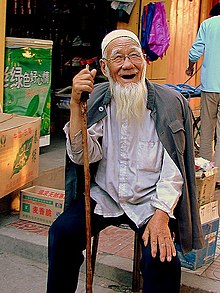
Back Hui-Chinese Afrikaans هوي Arabic هوى ARZ Hueylər Azerbaijani هوئی خالقی AZB Хуэй Byelorussian Хуей Bulgarian হুয়েই জাতি Bengali/Bangla ཧུད་མི། Tibetan Ètnia hui Catalan
回族 خُوِزُو | |
|---|---|
 An elderly Hui man | |
| Total population | |
| 11,377,914 (2020) | |
| Regions with significant populations | |
| China, Kazakhstan, Kyrgyzstan, Myanmar, Thailand | |
| Languages | |
| Predominantly Mandarin Chinese and other Sinitic languages | |
| Religion | |
| Predominantly Sunni Islam[1][2][3] | |
| Related ethnic groups | |
| Han Chinese • Bai Tibetan Muslims |
| Hui people | |||||||||||||||||||||||||||||||||||||||||||||||
|---|---|---|---|---|---|---|---|---|---|---|---|---|---|---|---|---|---|---|---|---|---|---|---|---|---|---|---|---|---|---|---|---|---|---|---|---|---|---|---|---|---|---|---|---|---|---|---|
| Chinese | 回族 | ||||||||||||||||||||||||||||||||||||||||||||||
| Literal meaning | Islam ethnicity | ||||||||||||||||||||||||||||||||||||||||||||||
| |||||||||||||||||||||||||||||||||||||||||||||||
The Hui people[a] are an East Asian ethnoreligious group predominantly composed of Chinese-speaking adherents of Islam. They are distributed throughout China, mainly in the northwestern provinces and in the Zhongyuan region. According to the 2010 census, China is home to approximately 10.5 million Hui people. Outside China, the 170,000 Dungan people of Kazakhstan and Kyrgyzstan, the Panthays in Myanmar, and many of the Chin Haws in Thailand are also considered part of the Hui ethnicity.
The Hui were referred to as Hanhui[b] during the Qing dynasty to be distinguished from the Turkic Muslims, which were referred to as Chanhui.[4][c] The Republic of China government also recognised the Hui as a branch of the Han Chinese rather than a separate ethnic group. In the National Assembly of the Republic of China, the Hui were referred to as Nationals in China proper with special convention.[5] The Hui were referred to as Muslim Han people[d] by Bai Chongxi, the Minister of National Defense of the Republic of China at the time and the founder of the Chinese Muslim Association.[6] Some scholars refer to this group as Han Chinese Muslims,[7][e] Han Muslims,[8][f] or Chinese Muslims,[9][g] while others call them Chinese-speaking Muslims or Sino-Muslims.[10]
The Hui were officially recognised as an ethnic group by the People's Republic of China government in 1954.[11] The government defines the Hui people to include all historically Muslim communities not included in China's other ethnic groups; they are therefore distinct from other Muslim groups such as the Uyghurs.[12]
The Hui predominantly speak Chinese,[13] while using some Arabic and Persian phrases.[14] The Hui ethnic group is unique among Chinese ethnic minorities in that it is not associated with a non-Sinitic language.[15] The Hui have a distinct connection with Islamic culture.[13] For example, they follow Islamic dietary laws and reject the consumption of pork, the most commonly consumed meat in China,[16] and have therefore developed their own variation of Chinese cuisine. They also have a traditional dress code, with some men wearing white caps (taqiyah) and some women wearing headscarves, as is the case in many Islamic cultures.
| Part of a series on Islam in China |
|---|
 |
|
|
- ^ "By choosing assimilation, China's Hui have become one of the world's most successful Muslim minorities". The Economist. 8 October 2016. Archived from the original on 7 October 2016. Retrieved 8 October 2016.
- ^ "الماتريدية وآثارها في الفكر الإنساني بدول طريق الحرير.. الصين نموذجا". Alfaisal Magazine.
- ^ "الحنفية الماتريدية في بلاد الصين". midad.com. 4 January 2020.
- ^ Ma, Rong (2008). "Types of the Ethnic Relationships in Modern China". Department of Sociology Institute of Sociology and Anthropology of Peking University. 28 (1): 1–23. ISSN 1004-8804.
- ^ Muslim Chinese : ethnic nationalism in the People's Republic. Gladney, Dru C. Cambridge, Mass,1996
- ^ 白崇禧先生訪問紀錄(下冊). 中央研究院近代史研究所. 2005. p. 574. ISBN 9789860459555.
- ^ Onuma, Takahiro (2009). 250 Years History of the Turkic-Muslim Camp in Beijing. Tokyo, Japan: Department of Islamic Area Studies, Center for Evolving Humanities, Graduate School of Humanities and Sociology, The University of Tokyo. p. 57. ISBN 978-4-904039-09-0.
- ^ Brose, Michael C. (2011). "Globalization and The Chinese Muslim Community in Southwest China". Asia Pacific: Perspectives. 10 (1): 61-80. ISSN 2167-1699.
- ^ Cieciura, Wlodzimierz (2018). "Chinese Muslims in Transregional Spaces of Mainland China, Taiwan, and Beyond in the Twentieth Century". Review of Religion and Chinese Society. 5 (2): 135-155. doi:10.1163/22143955-00502002.
- ^ Yu, Minling, ed. (2012). Liang an fen zhi: xue shu jian zhi, tu xiang xuan chuan yu zu qun zheng zhi (1945-2000). Zhong yang yan jiu yuan jin dai shi yan jiu suo. pp. 395–428. ISBN 978-986-03-3147-9. OCLC 816419264.
- ^ "中国民族". www.gov.cn. Retrieved 6 November 2024.
- ^ Lipman 1997, p. xxiii or Gladney 1996, pp. 18–20 Besides the Hui people, nine other officially recognized ethnic groups of PRC are considered predominantly Muslim. Those nine groups are defined mainly on linguistic grounds: namely, six groups speaking Turkic languages (Kazakhs, Kyrgyz, Salars, Tatars, Uyghurs and Uzbeks), two Mongolic-speaking groups (Bonan and Dongxiang) and one Iranian-speaking group (Tajiks).
- ^ a b Gladney 1996, p. 20.
- ^ Dillon 2013, pp. 154–.
- ^ Lipman 1997, p. 50 Of course, many members of some other Chinese ethnic minorities don't speak their ethnic group's traditional language anymore and practically no Manchu people speak the Manchu language natively anymore; but even the Manchu language is well attested historically. Meanwhile, the ancestors of today's Hui people are thought to have been predominantly native Chinese speakers of Islamic religion since no later than the mid or early Ming dynasty. [i.e. the late 14th to late 16th centuries]
- ^ Gladney 1996, p. 13.
Cite error: There are <ref group=lower-alpha> tags or {{efn}} templates on this page, but the references will not show without a {{reflist|group=lower-alpha}} template or {{notelist}} template (see the help page).